German
-
Brahms - Var. on a Theme of R. Schumann - Piano
 Variations on a Theme of Robert Schumann, Op.23, by J. Brahms
Variations on a Theme of Robert Schumann, Op.23, by J. BrahmsTranscribed for Piano Solo by John W. Pratt, PDF $19.75
Brahms wrote his beautiful Variationen über ein Thema von Robert Schumann for piano four hands, but essentially all the musical ideas are captured in this transcription for solo piano. The variations range from delicately decorative to spectral to warmly Brahmsian to bravura and even witty. The last, suffused with sadness, solemnity, resignation, and reaffirmation, combines a funeral march with the theme, which is known as Schumann's last idea because it came to him at night shortly before his attempted suicide and final commitment to an asylum.
Piano score, 21 pages; Total, 23 pages.
Preview -
Brahms – Variationen über ein Thema von Robert Schumann – Pf, Fl, Ob, Cl, Bn
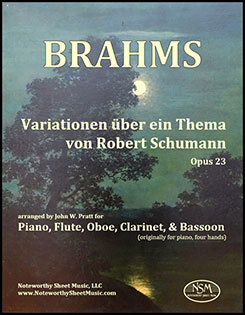 Variationen über ein Thema von Robert Schumann, Op.23, by Johannes Brahms
Variationen über ein Thema von Robert Schumann, Op.23, by Johannes BrahmsArranged for Piano, Flute, Oboe, Clarinet, and Bassoon by John W. Pratt
Piano Score and Wind Parts, PDF $16.99
- adapted from John W. Pratt’s foreword to the edition: Brahms’s Variations on a Theme by Robert Schumann, Op.23, were written in tribute to his friend, for piano four hands. Yet how often have you heard this exquisite masterpiece, in any form? Arranging it as a quintet for piano and winds allows realization of its implicit orchestral effects and incorporation of contrasting and beautiful woodwind sonorities while preserving its many special piano sonorities and its personal, chamber music qualities and will, hopefully, encourage performance. The variations range from delicately decorative (Var. I) to spectral (IV) to warmly Brahmsian (many) to bravura (IX) and even perhaps witty (V and VII). The final variation (X) is an amazing valedictory, a funeral march which becomes combined with the theme and is suffused throughout with sadness, solemnity, resignation, and reaffirmation, by turns and even simultaneously. Especially apt contributions by the woodwinds in this arrangement include, to mention just two, the appreciative chuckles accompanying the rollicking theme of Var. V and the chorale effect at the end of Var. X. At the same time, the arrangement allows the piano to fulfill its usual roles in chamber ensembles and to contribute some special colorings of its own, including the multi-octave filigree of Var. I, the layout of the accompaniments in the first part of Var. III and last part of Var. V, the bass rumbles of Var. IV and Var. X, and the two-hand octaves in Var. VI and Var. IX.
Listen to a computer-generated audio clip of the Theme; of course, real live instruments will sound even better:
The Preview below is a page of the score from Var. VI. Note that the score is presented in concert pitch.
Score, 28 pages; Flute, Oboe, B-flat Clarinet, and Bassoon parts, 4 pages each; Total, 48 pages.
Preview
-
Brahms ― Sonata, Op.120 No.1 ― Alto Flute
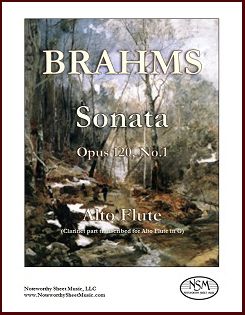 Sonata, Op.120 No.1, by Johannes Brahms
Sonata, Op.120 No.1, by Johannes BrahmsTranscribed for Alto Flute by J.W.Pratt
Alto Flute Part, PDF $8.99
Although written originally for clarinet, Brahms himself created two more versions of his Op.120 sonatas, for violin and viola. John W. Pratt, who transcribed these works for alto flute so expertly, writes in his foreword: "If Brahms was happy with versions for clarinet, viola, and violin, surely he would have welcomed arrangements for alto flute, especially since it is the mellow rather than the clarion aspect of the clarinet that he called on. In making our arrangements for alto flute, the violin versions have been particularly helpful, since the violin has the same lower range as the alto flute, but they required modification for several reasons. One, of course, is that the alto flute cannot play as loudly at the bottom of its range as the violin can. Another is that Brahms gave the violin double stops even though the clarinet is limited to a single voice." Our editions of the two Op.120 sonatas include only the alto flute parts, as Brahms' piano scores are freely available in the public domain. Here is a link to the listing of Op.120 No.1 on IMSLP.org, where the clarinet, viola, and violin versions with piano scores may be found. Our alto flute arrangements are based on the usual piano parts that accompany the clarinet as the solo instrument. The entire transcription of Op.120 No.1 works remarkably well, but the breathtakingly beautiful slow movement played on alto flute will steal your heart away.
Alto Flute part, 9 pages; Total 14 pages.
Preview -
Brahms ― Sonata, Op.120 No.2 ― Alto Flute
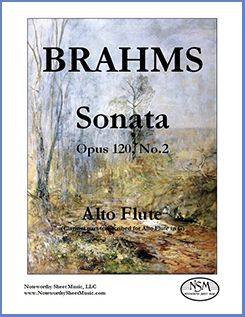 Sonata, Op.120 No.2, by Johannes Brahms
Sonata, Op.120 No.2, by Johannes BrahmsTranscribed for Alto Flute by J.W.Pratt
Alto Flute Part, PDF $8.99
This is the second of Brahms' two clarinet sonatas, transcribed for alto flute by John Pratt. Although written originally for clarinet, Brahms himself created two more versions of his Op.120 sonatas, for violin and viola. Mr. Pratt, who transcribed these works for alto flute so expertly, writes in his foreword: "If Brahms was happy with versions for clarinet, viola, and violin, surely he would have welcomed arrangements for alto flute, especially since it is the mellow rather than the clarion aspect of the clarinet that he called on. In making our arrangements for alto flute, the violin versions have been particularly helpful, since the violin has the same lower range as the alto flute, but they required modification for several reasons. One, of course, is that the alto flute cannot play as loudly at the bottom of its range as the violin can. Another is that Brahms gave the violin double stops even though the clarinet is limited to a single voice." Our editions of the two Op.120 sonatas include only the alto flute parts, as Brahms' piano scores are freely available in the public domain. Here is a link to the listing of Op.120 No.2 on IMSLP.org, where the clarinet, viola, and violin versions with piano scores may be found. Our alto flute arrangements are based on the usual piano parts that accompany the clarinet as the solo instrument.
Alto Flute part, 8 pages; Total, 12 pages.
Preview -
Bruch - Eight Pieces - Alto Flute
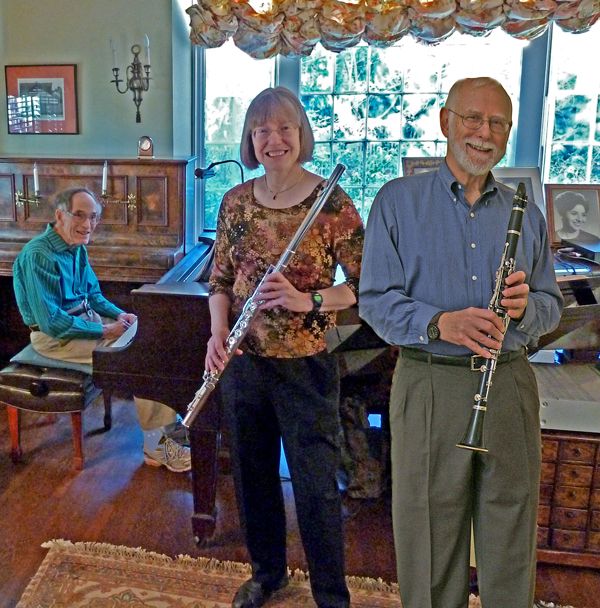 Acht Stücke, Op.83, by Max Bruch
Acht Stücke, Op.83, by Max BruchTranscribed for Clarinet, Alto Flute, and Piano by Davies, Pratt, and Vater
Alto Flute Part, PDF $9.98
Originally scored for clarinet, viola, and piano (or violin, cello, and piano), Bruch's Acht Stücke (Eight Pieces) adapts nicely for a trio with clarinet, alto flute, and piano. Bruch's beautiful melodies are well served by the rich tones of the alto flute.
In creating this transcription of the viola part for alto flute, we have taken great care to maintain the spirit and character of the original instrumentation. We provide here the alto flute part. The piano and clarinet parts are readily available in the public domain as free pdf downloads of the score and parts. Here is a link to one such source: Piano Score and Clarinet Part
Alto Flute part, 17 pages; Total, 19 pages.
Preview -
Danzi - Grande Sonate - Piano & Basset Horn
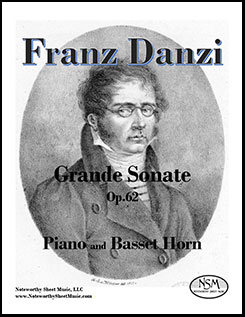 Grande Sonate, Op.62, by Franz Danzi
Grande Sonate, Op.62, by Franz Danzifor Piano and Basset Horn; re-notated, edited, and with occasional ossia elaborations suggested by John W. Pratt
Piano Score and Basset Horn Part, PDF $13.99
Franz Danzi (1763-1826) was an active musician, cellist, and teacher in Mannheim, Munich, Stuttgart, and Karlsruhe. A prolific composer, especially of music for the stage and chamber music from keyboard solos to sextets, he revered Mozart and mentored Weber. His wind quintets are notable. His Grande Sonate, Opus 62, for piano and basset horn, was published about 1823, along with an alternative cello part which sometimes differs from the basset horn part in other ways than octave transposition. // The original publication of Danzi’s Opus 62 is available at imslp.org., but there is no full score and the parts are hard to play from, or sometimes even to read at all, lack measure numbers, have a few errors, and differ in the number of measures in the last two movements. We have therefore prepared a full score including the basset horn in concert pitch, to facilitate checking the fit of the basset horn and piano lines and our transcriptions for other instruments against the original. — excerpted from John Pratt’s foreword to the edition
Piano Score, 28 pages; Basset Horn part, 7 pages; Total 40 pages.
Preview -
Danzi - Grande Sonate - Piano & Flute
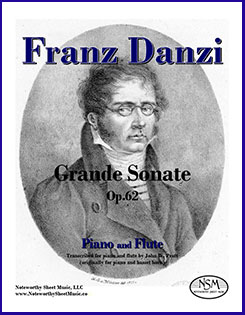 Grande Sonate, Op.62, by Franz Danzi
Grande Sonate, Op.62, by Franz Danzitranscribed for Piano and Flute by John W. Pratt
Piano score and Flute part, PDF $14.99
excerpted from John Pratt’s foreword to the edition: 'Franz Danzi (1763-1826) was an active musician, cellist, and teacher in Mannheim, Munich, Stuttgart, and Karlsruhe. A prolific composer, especially of music for the stage and chamber music from keyboard solos to sextets, he revered Mozart and mentored Weber. His wind quintets are notable. His Grande Sonate, Opus 62, for piano and basset horn, was published about 1823, along with an alternative cello part which sometimes differs from the basset horn part in other ways than octave transposition. // The sound of the basset horn varies widely, depending on its construction, who is playing, what is being played, and who is describing it. George Bernard Shaw said, ''The devil himself could not make a basset horn sparkle.'' Burnet Tuthill, in Cobbett's Cyclopedic Survey of Chamber Music (1929), wrote of its "soft mellow timbre of rich beauty.” E.T.A. Hoffmann likened its sound to the scent of red carnations (see Georgina Dobré, The Basset Horn,who says, pace Shaw, “Sparkle it certainly can!”). That tent is broad enough to cover the characteristics of both the flute and the clarinet comfortably, and Danzi’s Grande Sonate alternates sparkle and mellow rich beauty in large measure.' Since we at NSM have grown quite fond of this piece, we decided to transcribe it for both flute and clarinet, so we and our friends could enjoy playing it. We offer here the flute edition, with a version for clarinet to follow in the coming weeks.
Piano score, 28 pages; Flute part, 7 pages; Total 40 pages.
Preview -
Danzi - Grande Sonate - Piano and Clarinet
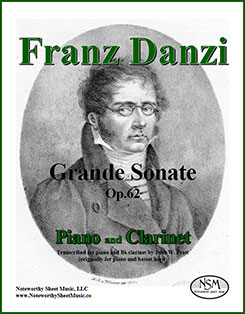 Grande Sonate, by Franz Danzi
Grande Sonate, by Franz Danzitranscribed for Piano and Clarinet by John W. Pratt
Piano score and B♭ Clarinet part, PDF $14.99
Danzi’s Grande Sonate, Opus 62, written for piano and basset horn, was published around 1823, along with an alternative part for cello. Please see additional information about this piece in the article describing our re-notated basset horn edition. The Grande Sonate comprises four movements and provides both sparkle and mellow rich beauty. It is nicely adaptable to other winds, particularly the clarinet. Certain passages in the final movement of the original work seem to invite elaboration or improvisation by the solo instrument, and arranger John Pratt offers suggestions for possible additions or alternatives for the clarinet, making it even more fun to play.
Piano Score, 28 pages; B♭ Clarinet Part, 7 pages; Total, 40 pages.
Preview -
Fürstenau - Adagio et Rondo Brillant - Fl & Pf
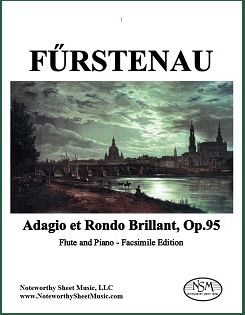 Adagio et Rondo Brillant, Op.95, by A. B. Fürstenau
Adagio et Rondo Brillant, Op.95, by A. B. FürstenauGassett Collection - Facsimile Edition by C.A.Vater/Noteworthy Sheet Music with a Foreword by Peter H. Bloom
Flute Part and Piano Score, PDF $12.00
Anton Bernhard Fürstenau (1792-1852) was among the most revered flutists of the 19th century. Following his appointment to the post of principal flute for the Royal Chapel at Dresden in 1820, Fürstenau became a valued colleague and close personal friend of the court's music director, Carl Maria von Weber. The influence of Weber's dramatic melodic gestures and edgy harmonic shifts can be heard in this passionately evocative Adagio et Rondo Brillant. An NSM favorite!
For additional information about the Gassett Collection, please see see our article An Introduction to the Gassett Collection.
Piano score, 12 pages; Flute part, 4 pages; Total, 20 pages.
Preview -
Gabrielsky - Adagio et Variations - Fl & Pf
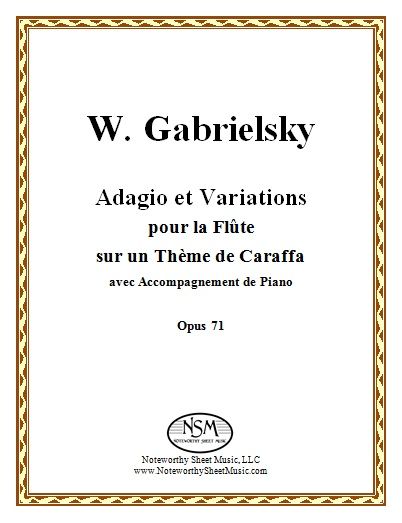 Adagio et Variations pour la Flûte sur un Thême de Caraffa, Op. 71, by W. Gabrielsky
Adagio et Variations pour la Flûte sur un Thême de Caraffa, Op. 71, by W. GabrielskyGassett Collection - New Edition by Noteworthy Sheet Music
Flute Part and Piano Score, PDF $18.75
Johann Wilhelm Gabrielski (or Gabrielsky), 1795-1846, was an acclaimed German flutist and composer from Berlin. In 1814 Gabrielski secured a position as flutist at the theatre in Stettin and within two years was appointed to the Royal Court. Gabrielski's compositions, of which there are more than 100, were highly esteemed and popular in his day. Although these works have much to offer modern day flutists as well, Gabrielski's music is neither widely known nor readily available today. The Adagio et Variations pour la Flûte, Op. 71, exploits melodic material by Michele Enrico Carafa (Caraffa) di Colobrano (1787-1872), a Naples born musician who had a remarkably successful career in Paris as a composer for the Opéra-Comique and as a professor of composition and counterpoint at The Conservatoire. The work showcases the flutist's virtuosity, atop a relatively uncomplicated piano accompaniment.
For additional information about the Gassett Collection, please see see our article An Introduction to the Gassett Collection.
Flute part, 11 pages; Piano Score, 16 pages; Total, 31 pages.
Preview -
Goepfart - Zwei Charakterstücke - Alto Flute and Piano
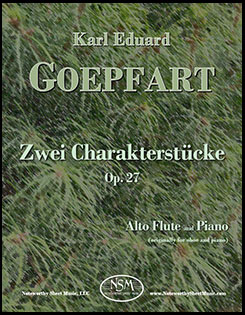 Zwei Charakterstücke, by Karl Eduard Goepfart
Zwei Charakterstücke, by Karl Eduard Goepfarttranscribed for Alto Flute and Piano by C. A. Vater
Alto Flute part and Piano score, PDF $8.99
Karl Eduard Goepfart (1859-1942) was a German pianist, composer and conductor. His Zwei Charakterstücke, Op. 27(Two Character Pieces) were written for oboe and piano and first published in Leipzig in 1888. The two contrasting pieces are the very charming Mässig schnell, gehend and Mässig langsam (in ruhiger Bewegung)with its playful, energetic Lebhaft section. We prepared a transcription of this under-appreciated work for alto flute, complete with piano score. The pieces work well on alto flute, providing the accompanying pianist is sensitive to the alto flute’s lower sound power and projection capability, especially in the low register, compared to that of the oboe.
Piano Score, 8 pages; Alto Flute part, 3 pages; Total, 16 pages.
Preview -
Hauptmann - Bereavement - Alto Flute & Piano
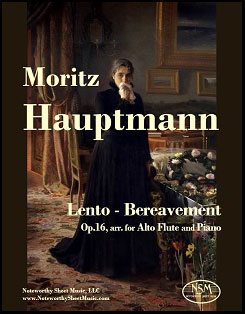 Lento - Bereavement, by Moritz Hauptmann
Lento - Bereavement, by Moritz HauptmannTranscribed for Alto Flute and Piano by C. A. Vater
Piano Score and Alto Flute Part, PDF $3.99
Hauptmann's 3 Violin Duos, Op.16 were first published in 1832. The Lento (Bereavement) from Op.16 later was arranged for violin and piano by the renowned violinist, violist, and composer Heinrich Wilhelm Ernst. It is this arrangement by Henri Ernst, published in 1880, that served as the basis for NSM’s transcription of the piece for alto flute and piano. The mournful simplicity of the Lento is perfectly captured and beautifully rendered by the alto flute.Alto Flute part, 1 page; Piano Score, 2 pages; Total, 6 pages.
Preview
-
Hauptmann - Lieder - Voice, Violin/Flute, Piano
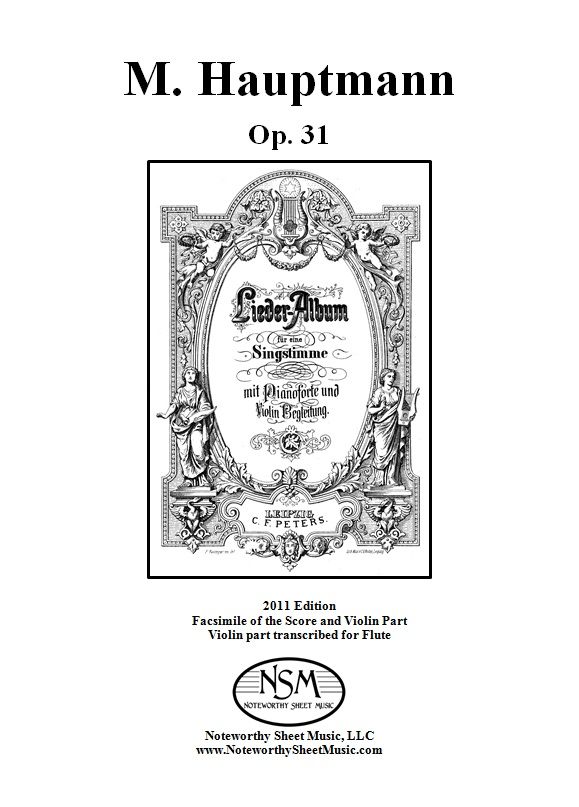 Meerfahrt, Nachtgesang, and Der Fischer, Op.31, by M. Hauptmann
Meerfahrt, Nachtgesang, and Der Fischer, Op.31, by M. HauptmannFacsimile Edition plus a Transcription of the violin part for Flute by C.A.Vater
Score for Violin, Voice, & Piano, Violin Part, and Flute Part, PDF $18.75
Moritz Hauptmann (1792-1868) was a renowned music theorist, pedagogue, violinist, and composer. In 1842, at Mendelssohn's recommendation, he was appointed cantor at the Thomasschule and professor of composition at the newly founded Leipzig Conservatory. Hauptmann published a major scholarly work on music theory in 1853, "Die Natur der Harmonik und Metrik" (The Nature of Harmony and Meter), as well as some 60 compositions.
Hauptmann's Op.31 comprises three lovely songs scored for voice with accompaniment of violin and piano: No.1, Meerfahrt (Sea Voyage); No.2, Nachtgesang (Night Song); and No.3, Der Fischer (The Fisherman). The vocal range extends from B3 to G5, and thus is well-suited for mezzo-soprano. These pieces were published by C. F. Peters as part of a larger volume, now in the public domain, entitled "Lieder-Album für eine Singstimme mit Pianoforte und Violin Begleitung". Our edition contains an "enhanced" facsimile of the original, plus a new transcription of the violin part for flute created using a modern music notation program. The three songs may be performed with comparable gratification utilizing the accompaniment of either violin or flute, along with the voice and piano.
Score, 15 pages; Violin part, 5 pages; Flute part, 5 pages; Total, 29 pages.
Preview -
Hoffmeister - Sonata in D minor - Flute and Clarinet
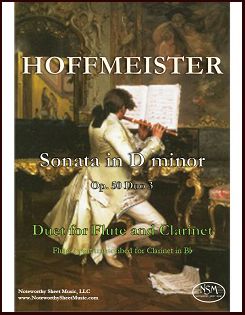 Sonata in D minor, Op.50, Duo 3, by Franz Anton Hoffmeister
Sonata in D minor, Op.50, Duo 3, by Franz Anton Hoffmeister
Duet transcribed for Flute and Bb Clarinet
Score and Parts, PDF $11.25
Noteworthy Sheet Music published an edition of the Sonata in D minor, Duo 3 from Hoffmeister's Trois Duos pour Deux Flûtes, Op.50, after being contacted by flutist Richard A. Evans. Years ago, Mr. Evans had located several editions of 18th and 19th century flute duets, long since out of print, at the Library of Congress. Finding them quite enjoyable to play, and believing them undeserving of their current obscurity, he and his music colleague Bronnie Stroud took the initiative of re-typesetting and editing the pieces using a modern music notation software program. Aware of the paucity of repertoire available for flute and clarinet duo, and realizing these pieces would work nicely for that instrument pair as well, he also transcribed the second flute parts for Bb clarinet. We at NSM agreed that these works should be made more readily available to present-day musicians and audiences, and we published them after making only minor stylistic and formatting revisions to Mr. Evans' scores and parts; the articulation and dynamic markings are those suggested by Mr. Evans.
Preview
Score, 15 pages; Flute part, 8 pages; Bb Clarinet part 8 pages; Total, 34 pages.
-
Hoffmeister - Sonata in D minor, Op.50, Duo 3 - Two Flutes
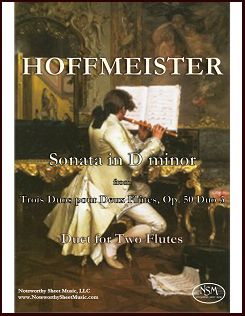 Sonata in D minor, Op.50, Duo 3, by Franz Anton Hoffmeister
Sonata in D minor, Op.50, Duo 3, by Franz Anton HoffmeisterDuet for Two Flutes
Score and Parts, PDF $11.25Franz Anton Hoffmeister (1754-1812) was a German music publisher and prolific composer. He studied law in Vienna, but after becoming captivated by the music scene in that city he devoted the rest of his life to music. His compositional output includes numerous symphonies and overtures, operas, string quartets, pieces for piano, and a great many compositions for flute, including concertos and chamber works. Noteworthy Sheet Music's edition of the Sonata in D minor, Duo 3 from Hoffmeister's Trois Duos pour Deux Flûtes, Op.50 was edited and notated by Richard A. Evans and Bronnie Stroud. Years ago, Mr. Evans located several original editions of 18th and 19th century flute duets, long since out of print, at the Library of Congress. He found them quite enjoyable to play, and undeserving of their current obscurity. NSM agreed and is offering updated editions of these flute-flute duets, as well as editions transcribed for flute and clarinet (browse under under Wind Ensembles or Clarinet).
 Click the mp3 icon to listen to a short audio sample of the Hoffmeister Sonata in D minor first movement, performed and recorded by Demi Stevens, a former student of Richard Evans, playing both parts of the duet.
Click the mp3 icon to listen to a short audio sample of the Hoffmeister Sonata in D minor first movement, performed and recorded by Demi Stevens, a former student of Richard Evans, playing both parts of the duet.
"This is a fabulous duet and has been incredibly fun to practice. Thank you for making it available!"
"Cheers to my mentor's awesome arrangement. I hope you enjoy! With love and admiration, ~Demi"Score, 15 pages; Flute-1 part, 8 pages; Flute-2 part, 8 pages; Total, 34 pages.
Preview
-
Loeffler - 4 Poèmes - Clarinet (Voice, Clarinet and Piano)
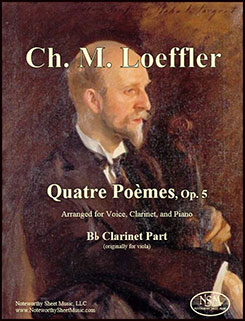 Quatre poèmes pour voix, alto et piano, by Charles Martin Loeffler
Quatre poèmes pour voix, alto et piano, by Charles Martin LoefflerViola part transcribed for Clarinet by C.A.Vater
Part for B-flat Clarinet; PDF $10.99
Noteworthy Sheet Music’s transcription of the viola part for Brahms’ Two Songs for Alto, Viola, and Piano, Op. 91 for clarinet quickly became one of our most popular editions, so we wanted to please our customers with another voice, clarinet, and piano option. We decided to create a clarinet version of the poems famously set to music by Charles Martin Loeffler (1861-1935). Quatre Poèmes pour Voix, Alto et Piano, Op. 5 was premiered by the Boston Symphony Orchestra with Loeffler himself on viola. In these four songs, Loeffler set to music one poem by Charles Baudelaire (“La cloche fêlée”) and three poems by Paul Verlaine (“Dansons la Gigue!”, “Le son du cor s’afflige vers les bois”, and “Sérénade”). Each of these songs has a unique character but Loeffler’s love of color variations and dense harmonies can be heard throughout the set.
We have taken care to adapt the viola part to the clarinet as conservatively as possible, and we think it works well. Obviously, there are places where we had to make modifications, and occasionally some difficult choices—for example where the viola has double stops, goes out of clarinet range, or uses harmonics or pizzicato. We encourage clarinetists who plan to perform this piece to listen to recordings of these songs with viola, and to consult the original viola part and score, available as free PDF downloads from imslp.org. Our edition includes only the transcribed clarinet part.B♭-Clarinet part, 10 pages; Total, 14 pages.
Preview
-
Mendelssohn - Concert Piece No.1 - Two Winds and Piano
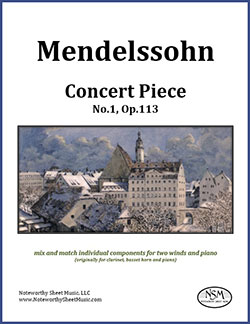 Concert Piece No.1, Op.113, by Felix Mendelssohn
Concert Piece No.1, Op.113, by Felix MendelssohnTranscribed for Various Wind Instruments and Piano by John W. Pratt
(originally for Clarinet, Basset Horn, and Piano)
Individual Primo parts for Clarinet, Flute, or Oboe, PDFs $6.99 each
Individual Secondo parts for Bassoon, Clarinet, or English Horn, PDFs $6.99 each
Piano Score, with original Clarinet and Basset Horn lines in concert pitch, PDF $6.99
The following is excerpted from John Pratt's © foreword:
"In 1833, Felix Mendelssohn (1809-1847) wrote two Concert Pieces for Clarinet, Basset Horn, and Piano, op. 113 and op. 114, as show-pieces for the famous clarinetist Heinrich Bärmann (1784-1847) to play with his up-and-coming son Karl (1811-1885) on the basset horn. // Mendelssohn's two Concert Pieces are very suitable for transcription, even aside from the rarity of the basset horn today. We provide, as well as the original clarinet part, transcriptions of it for flute and oboe. Transcriptions of the basset horn part are provided for bassoon, clarinet, and English horn. These primo and secondo parts can be mixed and matched at will. For the score, we use Mendelssohn's instruments rather than some other arbitrary pair. This enables anyone interested to check any transcribed part against the original. The score gives the parts in concert pitch, because a transposition would apply to only one of the possible winds, and because the pianist can then easily play any part at original pitch."Please note that PDFs of the original score and clarinet-primo part are available free of charge in the public domain (see the listing of this work on IMSLP.org), and our transcribed primo and secondo wind parts can readily be used with the original score. Therefore, you should purchase our original instrument Score or Clarinet-primo part only if you would like measure numbers or Mr. Pratt's score (for piano with clarinet and basset horn) in concert pitch.
- Piano Score with Clarinet and Basset Horn lines in concert pitch, 8 pages; Total, 10 pages (note that the original score is freely available on IMSLP.org)
- Clarinet in B-flat, primo part, 4 pages; Total, 6 pages (note that the original clarinet part is freely available on IMSLP.org)
- Flute, transcribed primo part, 4 pages; Total, 6 pages
- Oboe, transcribed primo part, 4 pages; Total, 6 pages
- Bassoon, transcribed secondo part, 4 pages; Total, 6 pages
- Clarinet in B-flat, transcribed secondo part, 4 pages; Total, 6 pages
- English Horn, transcribed secondo part, 4 pages; Total, 6 pages
-
Mendelssohn - Concert Piece No.2 - Two Winds (and Piano)
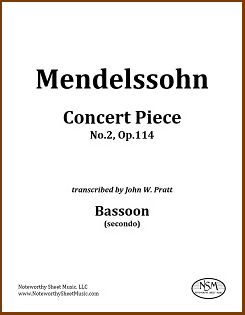 Concert Piece No.2, Op.114, by Felix Mendelssohn
Concert Piece No.2, Op.114, by Felix MendelssohnTranscribed for Various Wind Instruments (and piano) by John W. Pratt
(originally for Clarinet, Basset Horn, and Piano)
Primo parts for Clarinet, Flute, or Oboe, PDFs $5.99 each
Secondo parts for Bassoon, Clarinet, or English Horn, PDFs $5.99 each
The following is excerpted from John Pratt's © foreword:
In 1833, Felix Mendelssohn (1809-1847) wrote two Concert Pieces for Clarinet, Basset Horn, and Piano, op. 113 and op. 114, as show-pieces for the famous clarinetist Heinrich Bärmann (1784-1847) to play with his up-and-coming son Karl (1811-1885) on the basset horn. // These works are very suitable for transcription, even aside from the rarity of the basset horn today. We provide, as well as the original clarinet part, transcriptions of it for flute and oboe. Transcriptions of the basset horn part are provided for bassoon, clarinet, and English horn. These primo and secondo parts can be mixed and matched at will. // Since a good quality PDF of the original piano score with excellent page turns is freely available in the public domain (see IMSLP.org), we have not provided a score here; our transcribed primo and secondo wind parts can readily be used with the original score.
Each wind part is 4 pages of music; 6 pages total.
Primo parts for Flute, Clarinet in B-flat (note that the original primo clarinet part is freely available on IMSLP.org), or Oboe.
Secondo parts for Clarinet in B-flat, Bassoon, or English Horn. Preview Bassoon II part
-
Mendelssohn - On Wings of Song - Alto Flute & Piano
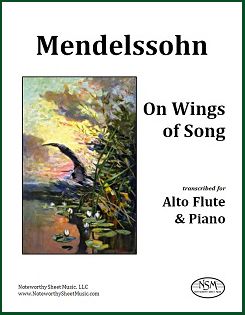 On Wings of Song, Op.34, No.2, by Felix Mendelssohn
On Wings of Song, Op.34, No.2, by Felix MendelssohnTranscribed for Alto Flute and Piano by C.A.Vater
Alto Flute Part and Piano Score, PDF $5.99
Having made significant contributions as a poet, essayist, journalist, and critic, Christian Johann Heinrich Heine (1797-1856) is considered one of the great German writers of the 19th century. Many of his romantic poems were chosen as the text for Lieder by such eminent composers as Schubert, Schumann, and Brahms. The Heine poem Auf Flügeln des Gesanges, which translates into English as On Wings of Song, was set to music by Felix Mendelssohn and published as No. 2 of six songs for voice and piano constituting his Opus 34. Auf Flügeln des Gesanges became one of Mendelssohn's most famous art songs, and remains popular to this day. Arrangements and transcriptions of the music have been created for small orchestra, flute and guitar, flute and piano, violin and piano, two violins, cello and piano, treble choir, and piano solo, among others. With its charming, simple melody and narrow pitch range, On Wings of Song is highly accessible and understandably a favorite of vocal and instrumental soloists of all levels. Our transcription is in the key of G, and the song is especially mellow and lovely when played on alto flute.
Alto Flute part, 1 page; Piano Score, 4 pages; Total, 8 pages.
Preview
=========================================================
We also offer a professionally-printed hard copy edition of On Wings of Song for $10.18 plus a shipping and handling fee. Please use the Contact Us form to let us know which hard copy publication(s) you would like to purchase, along with your contact information and USPS mailing address. We will then send you a PayPal invoice for the sale and, once we receive notice from PayPal that you have paid for the item(s), we will ship your music to the address provided.
=========================================================
-
Popp - Greetings to Hungary - Flute and Piano
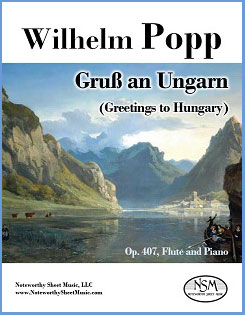 Greetings to Hungary, Op.407, by Wilhelm Popp
Greetings to Hungary, Op.407, by Wilhelm PoppFlute and Piano
Flute Part and Piano Score, PDF $0.00
Wilhelm Albrecht Otto Popp (1828-1903) was an esteemed German composer, flutist, and pianist. He received his flute training from Caspar Kummer and Louis Drouet, and served as court pianist and flutist at the Ducal Saxon Court Theater in Coburg-Gotha. In 1867 he moved to Hamburg and became first flute of the Hamburg Philharmonic Orchestra. Popp composed some 600 works, many of which were written for flute and piano; most of his compositions were published in his lifetime and were well-known to musicians of his day.
Wilhelm Popp’s Gruß an Ungarn (Greetings to Hungary) was first published for flute and orchestra in 1890, and an edition for flute and piano was published in 1899. NSM re-notated the flute and piano version, changing only the formatting and adding bar numbers and a new cover page. With a decidedly Hungarian sentiment, this piece is great fun to play and provides an enjoyable, exciting listen for audiences as well.
Click for a free download of our re-typeset edition of Popp’s Gruß an Ungarn.
Piano score, 8 pages; Flute part, 5 pages; Total 16 pages.